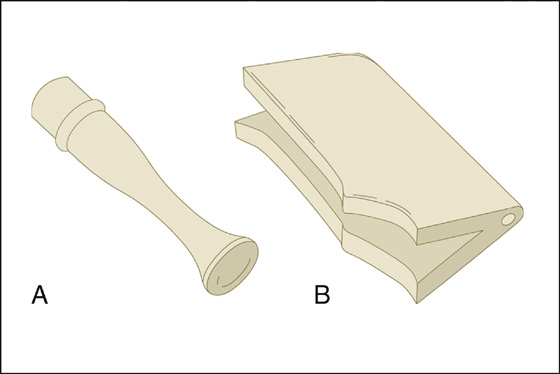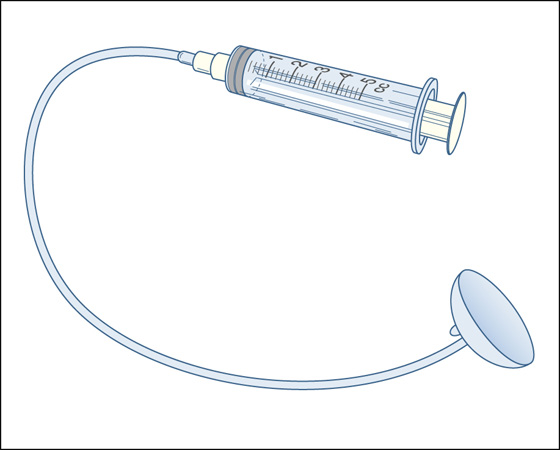CHAPTER 23
Removal of Dislocated Contact Lens
Presentation
The patient may know that the lens has dislocated into one of the recesses of the conjunctiva and complains only of the loss of refractory correction, or he may have lost track of the lens completely, in which case the eye is a logical place to look first. Pain and blepharospasm suggest a corneal abrasion, perhaps resulting from attempts to remove an absent lens that was thought to be still in place.
What To Do:
 If pain and blepharospasm are a problem, topically anesthetize the eye.
If pain and blepharospasm are a problem, topically anesthetize the eye.
 Pull back the eyelids as if looking for conjunctival foreign bodies, invert the upper lid, and, if necessary, instill fluorescein dye (a last resort with soft lenses, which absorb the dye tenaciously).
Pull back the eyelids as if looking for conjunctival foreign bodies, invert the upper lid, and, if necessary, instill fluorescein dye (a last resort with soft lenses, which absorb the dye tenaciously).
 If the lens is loose, slide it over the cornea, and let the patient remove it in the usual manner. Irrigation may loosen a dry, stuck lens.
If the lens is loose, slide it over the cornea, and let the patient remove it in the usual manner. Irrigation may loosen a dry, stuck lens.
 For a more adherent hard lens, use a commercially available suction cup lens remover. Soft lenses may be pinched between the fingers, or a commercially available rubber pincer can be used (Figure 23-1). Another option is to take a Morgan irrigation lens attached to a 5-mL syringe filled with 2 mL of normal saline. Flush the Morgan lens with the saline, place the lens over the contact, aspirate on the syringe to produce suction, and remove the Morgan lens and the contact lens together from the conjunctival sac (Figure 23-2).
For a more adherent hard lens, use a commercially available suction cup lens remover. Soft lenses may be pinched between the fingers, or a commercially available rubber pincer can be used (Figure 23-1). Another option is to take a Morgan irrigation lens attached to a 5-mL syringe filled with 2 mL of normal saline. Flush the Morgan lens with the saline, place the lens over the contact, aspirate on the syringe to produce suction, and remove the Morgan lens and the contact lens together from the conjunctival sac (Figure 23-2).

Figure 23-1 A, Rubber suction cup used for extracting hard lenses. B, Rubber pincer used for extracting soft lenses.

Figure 23-2 Morgan lens attached to a 5-mL syringe.
 Put the lens in a proper container with sterile saline.
Put the lens in a proper container with sterile saline.
 Complete the eye examination, including best-corrected visual acuity assessment and bright-light and fluorescein examination. Treat any corneal abrasion as explained in Chapter 16.
Complete the eye examination, including best-corrected visual acuity assessment and bright-light and fluorescein examination. Treat any corneal abrasion as explained in Chapter 16.
 Instruct the patient to refrain from wearing the lens until all symptoms have abated for 24 hours and to see his ophthalmologist if there are any problems.
Instruct the patient to refrain from wearing the lens until all symptoms have abated for 24 hours and to see his ophthalmologist if there are any problems.
What Not To Do:
 Do not give up on locating a missing lens too easily. Lost lenses have been excavated from under scar tissue in the conjunctival recesses years after they were first dislocated.
Do not give up on locating a missing lens too easily. Lost lenses have been excavated from under scar tissue in the conjunctival recesses years after they were first dislocated.
 Do not omit examination with fluorescein stain for fear of ruining a soft contact lens. The dye may take a long time to elute out, but it is most important to find the dislocated lens.
Do not omit examination with fluorescein stain for fear of ruining a soft contact lens. The dye may take a long time to elute out, but it is most important to find the dislocated lens.
The deepest recess in the conjunctiva is under the upper lid, but lenses can lodge anywhere; in extremely rare cases, lenses have perforated the conjunctival sac and migrated posterior to the globe. Be sure to evert the upper conjunctival sac by pushing down with a cotton-tipped applicator (see Chapter 17). Often, no lens can be found because the lens was missing from the start, through actual loss or forgetfulness.

Full access? Get Clinical Tree


